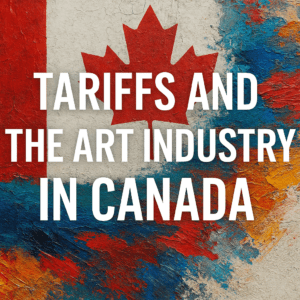The Impact of U.S. Tariffs on Art Supplies and Products in British Columbia

The recent imposition of U.S. tariffs on Canadian goods has introduced significant challenges for the art community in British Columbia, particularly in North Vancouver. These tariffs affect not only the cost of art materials but also the sale and exhibition of artworks between Canada and the U.S. In this article, we’ll explore the impact of these tariffs on local artists, art instructors, and businesses like Jey Art Studio, and what strategies can help navigate these economic shifts.
Rising Costs of Art Supplies in BC
Many art supplies used by Canadian artists are either imported from the U.S. or contain U.S.-sourced materials. With tariffs in place, the prices of essential items such as:
Canvas & paper (especially high-quality imported brands)
Acrylics, oils, and watercolors
Brushes and sculpting tools
Pottery materials and equipment
have seen a notable price increase. At Jey Art Studio (315 Lonsdale Ave, North Vancouver), we source high-quality materials for our painting and pottery classes, and we’ve seen firsthand how these increased costs affect both students and instructors. For more insights on how tariffs affect Canadian art supplies, visit the Canadian Artists Network.
Impact on Art Sales & Exhibitions
For local artists and galleries in BC, the tariffs have made it more expensive to export artworks to the U.S. Many North Vancouver-based artists, including those from Jey Art Studio, participate in international art fairs, but rising shipping costs and tariffs are making it less feasible. Collectors in the U.S. may also hesitate to purchase Canadian artworks due to these increased costs. As a result, artists are looking for alternative markets, including focusing more on the local BC art scene and increasing their online presence to reach global buyers. For details on current tariff policies, refer to the Government of Canada’s Trade & Tariff Updates.
How BC Artists Are Adapting
Despite these challenges, North Vancouver artists and studios are finding ways to cope with these economic changes:
Buying locally: Many artists are shifting to Canadian-made art supplies to avoid extra
import costs.
Exploring digital art: Digital illustrations and prints require fewer imported materials.
Expanding local art sales: More BC artists are focusing on selling within Canada through local exhibitions, community markets, and online shops.
Government and Community Support
To assist artists and art businesses in BC, the Government of British Columbia has introduced informational workshops on adapting to the new tariff environment. Additionally, local art associations, such as North Van Arts, are offering support by connecting artists with new resources and funding opportunities. Check out North Van Arts for local art community updates and resources.
Supporting Local Art Businesses
One of the best ways to help BC artists and art studios is by shopping locally. If you’re looking for art classes in North Vancouver, consider supporting businesses like Jey Art Studio, which provides painting, drawing, and pottery classes for all ages. By choosing a local art studio, you’re not only learning a new skill but also helping strengthen the BC art community in these challenging times.
Conclusion
The U.S. tariffs on art supplies have created hurdles for BC artists, but through local support, adaptive strategies, and community engagement, we can continue to foster a thriving North Vancouver art scene. If you are passionate about art and creativity, now is the time to support local artists, art instructors, and businesses.

